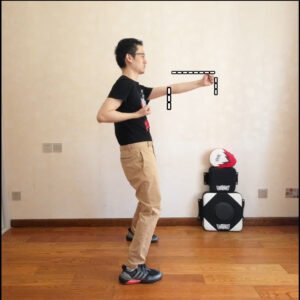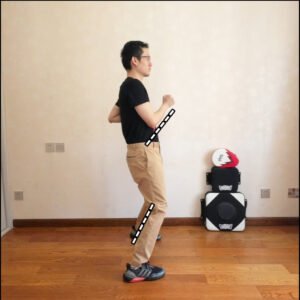Following the central axis, now we do a punch, but before we talk about the punch here, let’s talk about 2 things first.
One is why we face our opponent squarely, or with two shoulders equally away from the opponent’s central axis. A lot of people argue about facing or side-facing, which one is superior; the answer is neither of them is superior to the other. When we are facing, we can use our two arms, even 3 limbs (plus one leg) equally, but we expose our whole front body to our opponent. When we are side-facing, we expose less, only a limited area of our body is closer to the opponent; however, what’s the cost? We only have one arm that is easy to use right now, and the other one can not reach the same distance, because of the shoulder joint connection, and we expose more chances for opponents get to our back side, so maybe a lot of people they are used to this kind of guard, they feel it’s superior, it’s not, the design of our human body is like this, no way we can guard ourselves perfectly, the pros and/or cons of one type is vice versa to the other, we just can’t be greedy and have them both.
Two is, this is the first movement where we start to train our two arms separately, and we always do the left one first in Ving Tsun, why? Because most of us are right-handed, we use our right hand a lot in daily life, it’s stronger, and we can control it more accurately. But in fights, our left hand and the opponent’s right hand are on the same side, mirroring side, so it’s very easy for them to meet each other, so the weaker one meets the stronger one, not good. In Ving Tsun, we emphasize the idea of being balanced, so we stress the left side(left arm and leg) heavily, so if you are left-handed, you should do your right side more.
Therefore, all movements in the form are based on those prerequisites; here is the first one. However, it looks like a punch, in real fights, no way we punch this way, this movement is telling us:
First, we should punch along the shortest, most direct path to the opponent’s central axis (both stationary and facing), which is our longest reachable distance. Which is also the connection between the two central axes. Imagine if you look from the top, draw a line between 2 points, and line them up.
Second, the mechanics of a Ving Tsun punch. And the habit we need to cultivate:
Elbow drives/pushes, fist leads, knuckles pointing forwards, aiming at the opponent’s central axis, mentioned as above; in this way, we won’t do a hammer fist or back fist. We can use the power from the ground combined with our stance, our structure. And we don’t withdraw, charge, which relies on distance for more power, from the armpit, to the centre of our chest, and extend the arm until fully extended, no detouring along the travel.
Finally, the most famous inch punch, its feature is from here. What do I mean by feature, punch without relying on distance, right? The most important point here is:
From the start to the end of the whole path, any point on this line can be the start or end of a punch.
Now you may understand, it’s not about one inch, two, or 3 inches, it’s just any distance from this line, that’s how important it is.
Additionally. Not only these, but also this is the most important technique we learn from the Little Idea, siu nim tao form of Ving Tsun, which we will talk about in the next few articles. They are all related.


